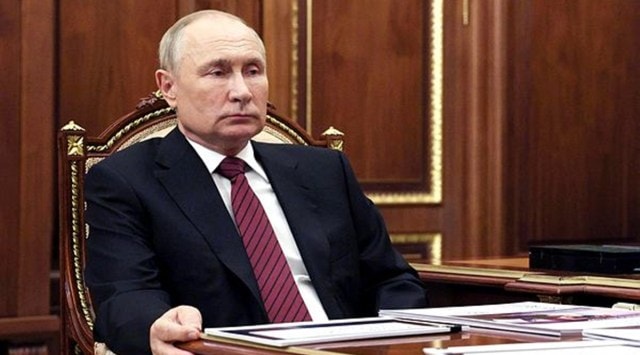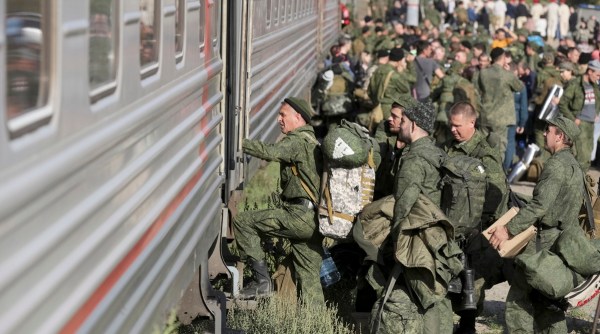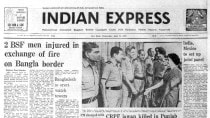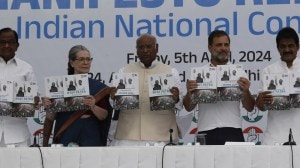- India
- International
With reverses in Ukraine, Putin’s options are shrinking
President Putin has no choice but escalation, given Russia’s current standing in the Russia-Ukraine war. This will test both Moscow's adversaries and friends
 Dividing the West is at the very heart of Putin’s Ukraine strategy but it is yet to produce a major success. (Gavriil Grigorov, Sputnik, Kremlin/Pool Photo via AP)
Dividing the West is at the very heart of Putin’s Ukraine strategy but it is yet to produce a major success. (Gavriil Grigorov, Sputnik, Kremlin/Pool Photo via AP)The war in Ukraine has entered a more dangerous phase after last week’s formal annexation of four districts of eastern Ukraine — Luhansk, Donetsk, Zaporizhzhia and Kherson — by Russia. Vladimir Putin’s decision presents new challenges for Russia, Ukraine, Europe, the US and the non-Western world, including India.
For Putin, the real test begins now. The triumphant ceremony in Moscow last Friday to mark the incorporation of eastern Ukrainian territories was marred by the fall of Lyman — an important logistical hub in the region. Ukraine’s armed forces are poised to make further advances all across the military front stretching well over 1,000 km. Putin’s claim to incorporate the four districts was strained by the fact that Russia did not have full military control over these territories.
As the gap between Putin’s political claims and the military reality on the ground widens, the Russian leader’s choices become narrower and will necessarily involve further escalation. His decision to mobilise new troops through conscription was an important step in that direction. But the resistance to the draft is real and many men of fighting age are fleeing the country.
Russia will eventually throw thousands of new troops into the battle. Greater fighting mass could help build a credible Russian line of defence in eastern Ukraine and provide a better military basis for Putin’s diplomatic strategy. But the performance of the Russian armed forces so far does not necessarily inspire optimism about the country’s prospects in eastern Ukraine. If Kyiv’s counteroffensive notches up new victories, the military and political pressure on Putin can only mount.
If the general mobilisation does not halt Ukraine’s counteroffensive, what options for escalation might Putin have? While global attention is focused on the potential use of nuclear weapons by Russia, it is unlikely that Putin would immediately turn to nuclear weapons. The Biden administration has said it has seen no signs of preparation to use nuclear weapons. Washington has warned Russia of catastrophic consequences if Moscow resorts to nuclear weapons.

 Ukrainian soldiers take positions in downtown Kyiv, Ukraine, Feb. 25, 2022. (AP, File)
Ukrainian soldiers take positions in downtown Kyiv, Ukraine, Feb. 25, 2022. (AP, File)
Putin might want to raise the scale and scope of the conventional attacks on civilian infrastructure in Ukraine that he has already begun. Russia could also turn to cyber attacks as well as physically target the Ukrainian military and political leadership. “Vertical escalation” — or intensification of the current military effort — is not the only option for Putin. He could try his hand at “horizontal escalation” that involves widening the war theatre. He could launch missile attacks on military supply lines from Poland and other East European countries. The prospect of a general European war could significantly raise the stakes in the Ukraine war.
While there is no betting horizontal escalation would work in Moscow’s favour, it could drag Europe to the nuclear precipice. The potential of a nuclear exchange between Russia and NATO, Putin might hope, would force the West towards a compromise starting with a ceasefire and talks. Ukraine was quick to dismiss Putin’s proposals for a dialogue that accompanied the formal annexation on Friday. Putin’s claims that eastern Ukraine is “now a part of Russia forever” and its new status is non-negotiable have diminished Kyiv’s incentives to talk. So has Ukraine’s successful counter-offensive.
Ukraine President Volodymyr Zelenskyy underlined his interest in a fair and dignified coexistence with Russia. He insisted that while there would be no talks with Putin, he might be open to engaging a future president of Russia. But Ukraine’s position on peace is inextricably tied to those of its Western backers. Any potential change in Western attitudes would alter Kyiv’s calculus.
If Putin continues to escalate, the divisions within the West could become more significant. There are at least three current Western approaches to Ukraine. One is the radical line from Central Europe and the UK that demands inflicting a decisive defeat on Putin’s Russia. Some sections of Western Europe, however, underline the importance of an early end to the war and the accommodation of at least some of Moscow’s concerns. Such a peace could be at the expense of Ukraine’s territorial integrity. Kyiv is not interested in trading land for peace at this moment. But the weight of those in Europe who put “peace” above “justice” might gain ground if the costs of the war become more manifest in winter.
The US has so far been able to keep the anti-Russia coalition together. It has also sought to limit the nature of support for Ukraine to prevent the use of Western weapons against Russian soil. But if the war widens and the danger of a nuclear war seems real, there are bound to be pressures on Washington to rethink its policy.
Dividing the West is at the very heart of Putin’s Ukraine strategy but it is yet to produce a major success. What about Putin’s hopes to mobilise political support in the non-Western world for his annexation of eastern Ukraine?
 Russian recruits take a train at a railway station in Prudboi, Volgograd region of Russia, Sept. 29, 2022. (AP)
Russian recruits take a train at a railway station in Prudboi, Volgograd region of Russia, Sept. 29, 2022. (AP)
Putin’s political justification of the annexation of eastern Ukraine on the basis of the traditional “Russkiy Mir” — or Russian World or sphere of influence — does not generate support in the former Soviet republics. Barring Belarus, few in Putin’s “near abroad” want to see the restoration of Putin’s “Great Historic Russia”.
Putin’s spectacular claim that his battle for Ukraine is part of an “emancipatory, anti-colonial movement against unipolar hegemony” that will reshape the world is unlikely to bestir the chancelleries of the Global South into a new crusade against Western “neocolonialism”. While most developing countries have their grievances against the US and the West, few are willing to support the Russian invasion. Only Eritrea, North Korea and Syria joined Belarus and Russia in voting against the UN General Assembly resolution deploring Moscow’s Ukraine invasion last March. Thirty-five countries, including India, from the non-Western world, abstained. Many of them made it clear that “abstention” was not “acquiescence” in Russian violation of Ukraine’s sovereignty and the UN Charter. China – Russia’s closest partner among the major powers — did not join Moscow in voting against the UNSC resolution denouncing the annexation of eastern Ukraine. India too abstained but signalled its “deep discomfort” with the Russian move.
But Putin has left himself little wiggle room to back down. Escalation — vertical and horizontal — seems his only option amidst the growing military setbacks. That, in turn, will severely test both his adversaries in the West and his friends among the rest.
The writer is senior fellow at the Asia Society Policy Institute, Delhi and contributing editor on international affairs for The Indian Express
EXPRESS OPINION
More Explained
Apr 25: Latest News
- 01
- 02
- 03
- 04
- 05











































